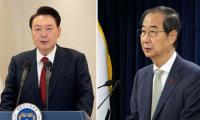There has been a stunning reversal of the promise of ‘change’ into a nightmare with the free fall of the rupee and the stock market. The regime is on the beaten track of “structural adjustment”, without a reversal of the huge imbalance between a fragile economic base and an overburdening parasitic superstructure, as the IMF and the Financial Action Task Force (FATF) tighten their noose around a dependent and debt-ridden economy of a warrior state.
Despite a structural adjustment course already underway since caretaker finance minister Shamshad Akhtar, which continued under Asad Umar, Pakistan has missed all the macroeconomic targets during the last 10 months of the PTI government. According to the National Accounts Committee (NAC), the provisional GDP growth is to be 3.3 percent against a target of 6.2 percent, resulting in the shrinking of per capita income by 8.2 percent with investment-to-GDP ratio going down to 15.4 percent against a target of 17.2 percent and savings-to-GDP ratio plummeting to 11.1 percent.
With significant reduction in agricultural growth and large-scale manufacturing dipping by 2.93 percent rather than growing at 8.1 percent, the economy is showing alarming signs of stagnation. Complimented by rising inflation touching almost double figures and higher interest rates, there are greater chances of stagflation rather than economic revival and stabilization. Despite over 34 percent devaluation, during the July-April period this fiscal year, exports remained lower than the comparable period last year, even though the trade deficit went down due to imports plummeting to $45.47 billion.
Quite disturbingly, the IMF has projected that Pakistan’s debt will swell from 72.1 percent of the GDP, left behind by the PML-N government in 2018, to 84.1 percent of the GDP and the fiscal deficit of 7.6 of the GDP by the end of Prime Minister Imran Khan’s tenure in 2023. Against a debt of Rs11 trillion piled up by the PML-N government in five years, the Imran Khan government would end up adding Rs5 trillion of debt in its first year.
Given this precarious state of economy and delayed half-baked responses as reflected by the two supplementary budgets and borrowing to the tune of $9 billion from three friendly countries, Imran Khan had to take another huge U-turn on his pledges not to beg money or go to the IMF. While sacking his right-hand man, former finance minister Asad Umar, in the middle of the parleys with the IMF and the World Bank, he brought in the World Bank/IMF duo, Abdul Hafeez Shaikh as adviser on finance and Reza Baqir as governor of the State Bank, to ostensibly win the confidence of the two donors.
Left with no option, the IK government had to sign on a tough 39-month Extended Fund Facility of $6 billion. For financial stabilization, Pakistan will still be needing more than $6 billion from the World Bank, Asian Development Bank and Pakistan’s international partners, including the Saudis and the Chinese who will also be persuaded to reschedule their debts. The IMF programme will come into effect only after the PTI government fulfils at least five major pre-conditions in the upcoming budget.
The conditions, among other numerous milestones, are: 1) a market-based free float exchange rate, expected to further devalue the rupee by 20 percent, and even beyond (as the market, in its speculative spree, is buying not selling dollars); 2) autonomy of the SBP and creation of an autonomous monitory committee to decide interest rates – expected to be raised by 200 points, or maybe more; 3) withdrawal of tax exemptions and subsidies and additional revenue generation of Rs700 billion; 4) reduction of primary fiscal deficit (excluding debt servicing) from 3 percent to 0.6 percent; most likely, the sacrificial goat in this will be the PSDP; and 5) cutting down losses or privatizing public-sector corporations, and massive increases in the prices of gas and electricity to overcome circular debt.
Not to my surprise, at least, the IMF has further linked its package to the anti-money laundering measures and the battle against terrorism financing, as also being hotly pursued by the FATF. Moreover, the most divisive clause is that the federal government has been asked to “engage provincial governments on exploring options to rebalance current arrangements in the context of the forthcoming National Finance Commission”. This will further sharpen the ongoing conflict between the federation and federating units on the thorny issues of resource distribution.
PM Imran Khan’s government is not the first to sign a structural adjustment facility with the IMF, but it is facing embarrassment for having broken its false pledges with the people. Successive governments have been going to the IMF to keep an unsustainable economy surviving and no stabilization program has ever produced desired results, like so many other under-developed economies. And we continue to repeat the same medicine without bringing fundamental changes in our real economy and in its exploitative relations of production; and adverse relationship with the over-determining civil-military bureaucratic structures.
In addition to the rent-seeking character of our elite, it is principally the contradiction between the economic base and the superstructure, accompanied by the pauperization of our masses and marginalization of oppressed peripheries that have kept us in perpetual crises. On the two internal and external deficit counts, we have continued to spend more than we had actually earned so as to pay for ever-increasing defence expenditures and an over-burdening superstructure of the state. We have continued to borrow to add to our debt; and due to our import substituting strategy we failed to expand the base and quality of our exports to keep our current account and balance of payments in our favour.
In fact, the political economy of our overall neo-colonial system is such that the ruling oligarchies, despite changes in governments, have continued to exploit our resources and the working people without caring for a sustainable people-centred growth. Instead of addressing the irreconcilable imbalance between the real economy and a national security state and catering to the needs of the working classes, attention is diverted to the fraction of political corruption to keep the status quo in favour of unproductive consumption by the powerful.
The projected outcomes as misleadingly claimed by the IMF’s EFF adjustment programme, such as reduction in inflation, unemployment, poverty, fiscal and current account deficits, current expenditures and an increase in investment, growth, exports, employment and development of physical and human infrastructures, are not likely to be realized. This is something that some of our most respectable economists have predicted.
In the best case scenario, we would be lucky if we stood where we are today by the end of the programme, and in a worst case scenario we may not be able to keep the programme and face further destabilization. Since most conditions are upfront and have to be embedded in the next budget, the IK government may have to possibly face mass reaction on the streets since people have no say in the policies that affect their lives so adversely.
The writer is a senior journalist. Email: imtiaz.safma@gmail.com
Twitter: @ImtiazAlamSAFMA
MPAs ask for their salaries and benefits to be at par with high court judges and exempt from tax
This system fosters and places premium on VIPs, facilitating VIP culture, which is alive and kicking
Imagine this waste covering over 15,500 cricket stadiums, piled three meters deep every year
If there is one thing that can be gleaned from politics today, it is that we no longer speak same language
Postman argues that “typographic mind” was yielding to “televisual mind”
Pakistan is well poised to meet opportunities that Artificial Intelligence will offer for developments in industries







